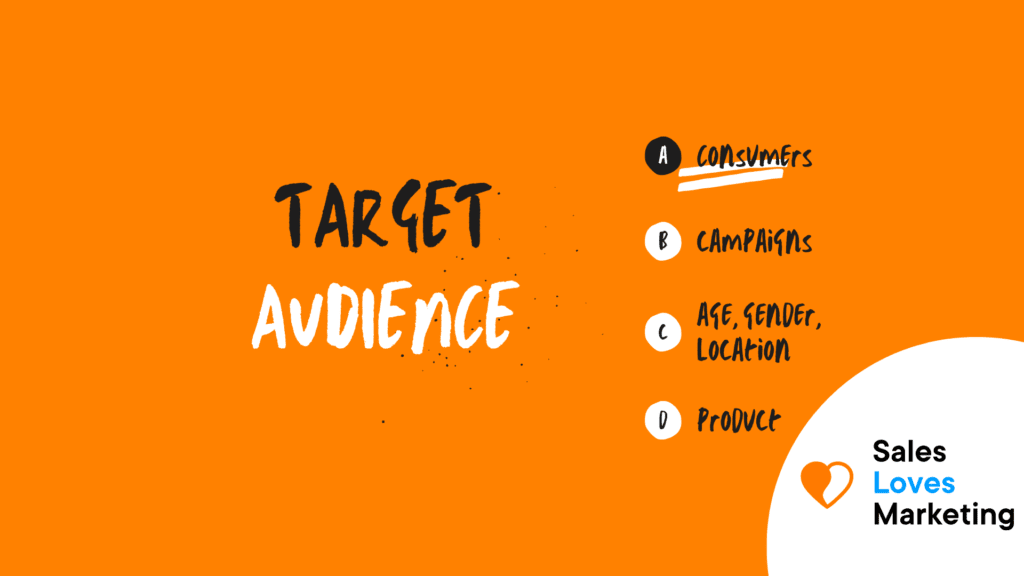What is the Target Audience?
The target audience is a part of consumers identified as potential customers who share demographic traits to which companies or businesses direct their marketing actions to make their products or services known.
Among the data most studied by companies they analyze to find their audience are:
- Age
- Gender
- Location
- Civil status
- Income level
- Level of education
- Occupation
Recommended Reading: Market Segmentation: What is it? And why it’s important for Marketing
Why is your Target Audience important?
As marketers, understanding your target audience is paramount. With this information, you can define the marketing strategy to be carried out.
Knowing that your target audience watches a particular show or reads a certain post means that an ad will have fewer views, but those views will be from the right people.
In addition to increasing ROI, studying and understanding the target market allows for optimal relationships and communication with customers. You can focus creativity on specific people and create brands and products that are in line with the interests of the people who are most likely to buy the product or service.
This is of the utmost importance in today’s times when customers expect all ads to be personalized. According to studies, 80% of consumers say they are more likely to buy products from brands that offer a personalized exchange.
Types of target audience
When identifying a target audience, different generations of people can be used to identify their tastes, customs, and way of life.
Maturist
This includes people born before 1945. This generation has deep-rooted traditions, and their advanced age doesn´t make them accustomed to today’s world and the extensive use of technology.
For this target audience, family and dependability are highly valued, as do jazz and swing-style music and written communication.
Baby boomers
Baby boomers are the generation of people born between 1946 and 1964, who are very close to retirement and whose work is very important in their lives. They were influenced by very big life changes, such as wars, world crises, and the acceptance of divorce.
Although they have started to handle the aspects of technology, they have not yet fully mastered them. Their main means of communication is the telephone, although they participate in social networks and the current Internet.
Generation X
These people were born between the years 1965 and 1978. They have a penchant for the internet and adapt easily to changes.
They have been part of and have experienced all the great changes in modern communication, from text messages, the first mobile phones, to e-mail communication.
They are individualistic, adapt, and consider the work environment as something more unstable and changeable than previous generations.
Generation Y (millennials)
Millennials are those born between 1981 and 1995; they are characterized by being very attached to the use of the smartphone as the main and only life device.
They were developed together with the internet, text messages, and social networks, so they are closely linked to technology, with which they seek comfort.
Generation Z (pivotals)
They are those people who were born between 1996 and today, so they have had extensive contact with technology but are not yet part of the job market.
They are characterized by being born together with technology and because they have great contact with it through consoles, games, and mobiles. Their life is connected to the digital world, and their hobbies are based on it.
Recommended Reading: PsychoGraphic Segmentation in Marketing
How to find your Target Audience?
- Collect data about existing customers and the social media audience.
Some of the data points to consider include:
- Age: there is no need to be too exact at this point. You have to focus on the generation your target audience is in.
- Geographic location (and time zone as well): helps you understand geographic areas to target and important hours when salespeople and customer service should be active. It can also be used to schedule the time to make public posts and announcements to improve visibility.
- Language and language: Do not assume that the target audience speaks only one language and also not the dominant language of the current physical location.
- Purchasing level and customs: you must know the amount of money the target audience has to spend for social networking sites and how they approach purchases in their price category.
- Interests: The activities that the target audience likes to do, the programs or television series they watch, and if they interact with other companies
- Life stage: what stage of life your target audience is in (college students, new parents, parents of teenagers, retirees)
Most of this information can be obtained through analysis of social networks, as well as the customer database itself.
It should not be assumed that customer demographics will match your target audience on social media, but knowing who is currently buying helps you know who is most likely to show interest on social media.
- Use social listening to find brand-related conversations.
A primary way to discover conversations about a business, industry, or its products is social listening. Relevant keyword scrutiny indicates what the public is saying about a brand and its competitors online, even when it’s not tagged.
Responding to these social posts is a good way to find your target audience.
- Find out the social media most used by the audience.
Once you have knowledge of who the audience could be and what the online topics are, it is good to investigate where they spend their time on social networks.
- Keep an eye on the competition.
Surely the audience on social networks overlaps with that of the competition. It is good to observe what they are doing to benefit from the lessons already learned by them.
